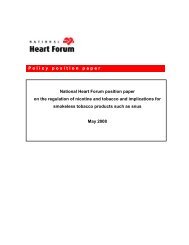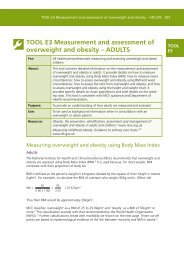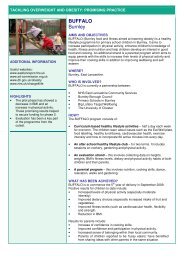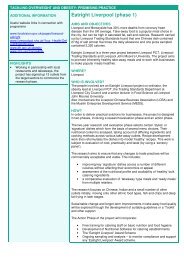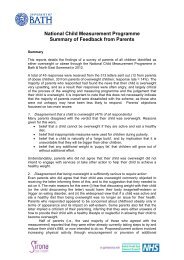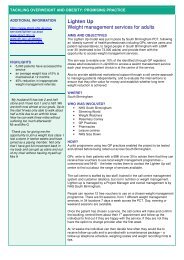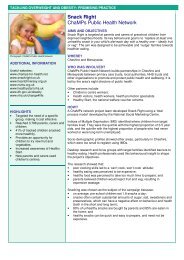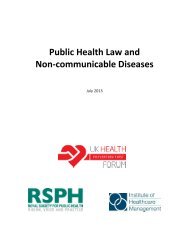The Challenge of Non-Communicable Diseases and Road Traffic ...
The Challenge of Non-Communicable Diseases and Road Traffic ...
The Challenge of Non-Communicable Diseases and Road Traffic ...
You also want an ePaper? Increase the reach of your titles
YUMPU automatically turns print PDFs into web optimized ePapers that Google loves.
An Overview 19<br />
For young men, RTI are the second leading cause<br />
<strong>of</strong> premature death after HIV/AIDS. Economically<br />
active young people are most at risk <strong>of</strong> road injury –<br />
in South Africa over half <strong>of</strong> pedestrian deaths were<br />
people aged 20-44 years. <strong>Road</strong> crashes are estimated<br />
to cost African countries between 1 <strong>and</strong> 3 percent <strong>of</strong><br />
their Gross National Product each year [63].<br />
FIGURE 8: Distribution <strong>of</strong> <strong>Road</strong> <strong>Traffic</strong> Deaths by<br />
Type <strong>of</strong> <strong>Road</strong> User in SSA Countries<br />
2 <strong>and</strong> 3 Wheelers – 7%<br />
Source: [59, 61]<br />
Cyclists – 7%<br />
Other – 5%<br />
Occupants – 43%<br />
Pedestrians – 38%<br />
Note that the small difference in the percentage <strong>of</strong> pedestrians between this source<br />
<strong>and</strong> [17], cited in the text above, results from differences in the countries included.<br />
FIGURE 9: Projected Disease Burden (DALYs) in SSA<br />
for Children Aged 5-15 Years, 2008-2030<br />
6000000<br />
5000000<br />
4000000<br />
3000000<br />
2000000<br />
1000000<br />
0<br />
2008 2015 2030<br />
Tuberculosis HIV/AIDS Malaria <strong>Road</strong> traffic injuries<br />
Source: Authors from [28]<br />
Projected DALYs by age, sex, <strong>and</strong> cause for 2008, 2015, 2030 – st<strong>and</strong>ard DALYS<br />
(3 percent discounting, age weights) – Baseline scenario.<br />
2.2. Economic <strong>and</strong> Social<br />
Development Consequences<br />
As the leading cause <strong>of</strong> death in low- <strong>and</strong> middle-income<br />
countries (LMIC), NCDs have costs for individuals<br />
<strong>and</strong> families, health systems <strong>and</strong> economies,<br />
<strong>and</strong> also for sustainable development. <strong>The</strong> two main<br />
factors accounting for the macroeconomic impacts<br />
are productivity loss—nearly 30 percent <strong>of</strong> NCD-related<br />
deaths in low-income countries occur in people<br />
under 60 years <strong>of</strong> age [64]—<strong>and</strong> costs <strong>of</strong> treatment,<br />
which pose particular challenges in LMIC<br />
where resources <strong>and</strong> health systems are already<br />
overstretched.<br />
Although the biggest economic burden is currently<br />
in high-income countries, the burden will rise in the<br />
developing world as economies enlarge <strong>and</strong> populations<br />
grow <strong>and</strong> age [65]. Rising NCD mortality rates<br />
are expected to reduce economic growth in developing<br />
countries [66]. A review <strong>of</strong> LMIC in 2007 estimated<br />
total losses in economic output during the<br />
period 2006–15 from coronary heart disease, stroke,<br />
<strong>and</strong> diabetes alone; namely, US$1.88 billion in South<br />
Africa, US$1.17 billion in Nigeria, US16 million in<br />
Ethiopia, <strong>and</strong> US15 million in Democratic Republic<br />
<strong>of</strong> Congo [67]. <strong>The</strong> estimated economic cost (direct<br />
<strong>and</strong> indirect) <strong>of</strong> diabetes alone in the African region<br />
in 2000 was I$25.51 billion 5 (at purchasing power<br />
parity) [68]. Total costs attributed to CVD in the African<br />
region were US$11.6 billion, <strong>of</strong> which 41 percent<br />
represented loss <strong>of</strong> productivity costs [65]. A review<br />
<strong>of</strong> over 7,000 employees in Namibia found that high<br />
blood glucose <strong>and</strong> diabetes had the largest effect on<br />
absenteeism, greater than being HIV positive [69].<br />
NCDs <strong>and</strong> the risk factors that fuel them can inflict<br />
substantial financial <strong>and</strong> psychosocial burdens<br />
on individuals <strong>and</strong> their families, particularly where<br />
treatment costs are paid mostly out-<strong>of</strong>-pocket. In<br />
the poorest households <strong>of</strong> some countries, 15 percent<br />
<strong>of</strong> disposable income is spent on tobacco [31].<br />
One study in Sudan showed that for a family with<br />
a diabetic child, 65 percent <strong>of</strong> their family’s annual<br />
health expenditure was spent on their child’s diabetic<br />
care [70]. A study <strong>of</strong> how households in Afri-<br />
5 I$ refers to International dollar which is a hypothetical unit <strong>of</strong> currency<br />
that has the same purchasing power parity that the U.S. dollar<br />
had in the United States at a given point in time.



